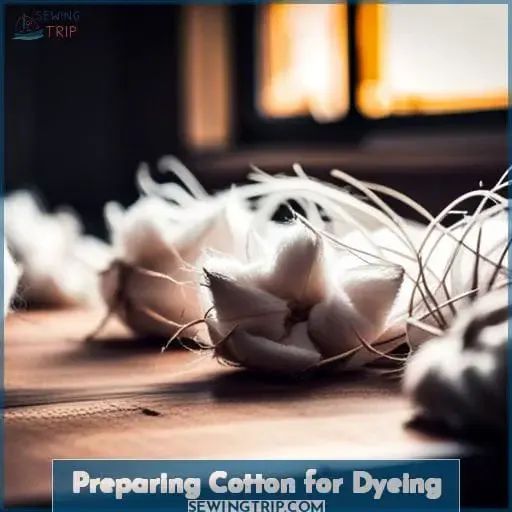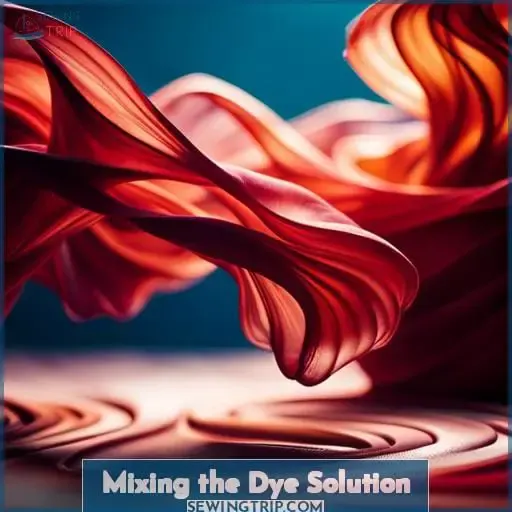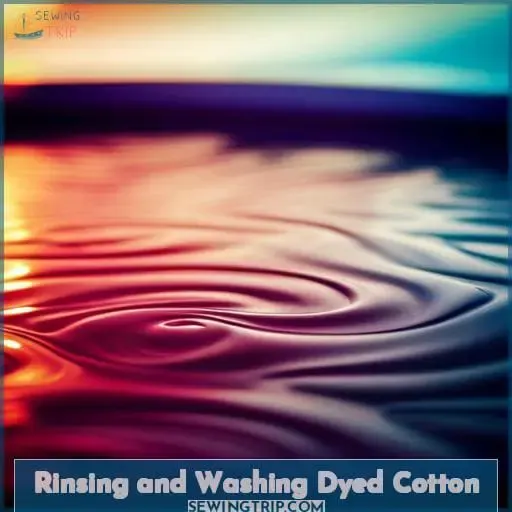This site is supported by our readers. We may earn a commission, at no cost to you, if you purchase through links.
 Last year, consumers spent over $54 billion on textiles!
Last year, consumers spent over $54 billion on textiles!
There’s power in altering the dyes we wear.
This do-it-yourself guide will liberate your inner colorist.
Learn how to easily transform old, washed-out cotton into vibrant shades at home.
Mix, soak, rinse – dye cotton without the mess.
With some basic supplies and these simple steps, you’ll breathe new life into tired t-shirts and linens.
Don’t just make do, dye cotton to suit your style.
The colors you crave are within reach, starting now.
Table Of Contents
Key Takeaways
- Wash cotton in hot water with detergent before dyeing to remove impurities and ensure dye absorption
- Premix the dye solution according to instructions before submerging the cotton
- Frequently stir and rotate the cotton in the dye bath for even coloring
- Rinse the dyed cotton thoroughly in cool water until water runs clear to achieve colorfastness
Preparing Cotton for Dyeing
Before dyeing cotton fabric at home, you’ll need to prep the material.
Wash the cotton in warm water with a mild detergent.
Soak it until fully saturated.
Smooth out any wrinkles in the damp fabric to help prevent an uneven, marbled look after dyeing.
Wash Cotton
Before dyeing cotton fabric at home, you’ll need to:
- Wash the cotton in your washing machine with detergent to remove any impurities like grease, starches, or waxes that may interfere with dye absorption.
- Use hot water for this initial wash cycle.
- Avoid using fabric softeners or dryer sheets as they can leave a coating that repels dye.
- Hot water
- Detergent
- No fabric softener
- No dryer sheets
- Extra rinse cycle
Soak Cotton
You’re always going to want to soak the cotton thoroughly in water before dyeing to ensure it’s fully saturated.
This helps the fabric absorb the dye more evenly and allows the color to penetrate deeper into the fibers.
Here’s a quick soaking guide:
| Fabric Weight | Water Temperature | Soaking Time |
|---|---|---|
| Light | Warm | 10 minutes |
| Medium | Warm | 15 minutes |
| Heavy | Hot | 20 minutes |
Soaking well hydrates the cotton prior to submerging it into the dye bath, resulting in rich, vibrant hues.
Properly saturated cotton readily accepts the dye for intense, long-lasting color.
Smooth Wrinkles
You want to smooth out any wrinkles in the cotton before dyeing to prevent an uneven, marbled look to the finished product.
Ironing with steam, placing between towels and pressing, or hanging to dry overnight are simple techniques for removing creases.
This pressing of the cotton allows the dye to penetrate evenly for uniform color saturation when submerged.
Preparing a wrinkle-free surface is a key step before at-home dyeing for flawless, crease-free results.
Mixing the Dye Solution
You’ll want to select an all-purpose clothing dye, choosing either powder or liquid dye.
Premix it with water in a small container before adding salt to intensify the color if using powdered dye.
For liquids, follow the dye bottle instructions carefully regarding dye-to-water ratios.
Powders offer more flexibility but require extra effort dissolving in hot water first.
Always use gloves, goggles, and work in a ventilated area when handling concentrated dye powder.
For intense, vivid colors, increase the dye-to-water ratio up to double the recommended amount.
But first, test a quarter batch on spare fabric to check the color saturation before going all in.
Synthetics usually need more dye than natural fibers.
For large batches, use buckets or bathtubs.
Divide dye powder into smaller containers near each soaking basin for quick, easy mixing rather than one giant vat.
With some trial and error, you’ll master glorious, customized colors to unleash your inner textile artisan.
Dyeing Cotton in a Bucket
To dye cotton fabric in a bucket:
Fill the bucket with hot water and pour in the premixed dye solution.
Submerging the cotton in a bucket allows you to dye larger quantities at once for vibrant colors across yards of fabric.
Choose a plastic basin or tub specifically for dyeing projects for easy cleanup afterward.
The bucket provides ample space to stir and rotate the fabric, ensuring the dye penetrates every thread for uniform coloring.
Quickly soak cotton yardage in creative ombre patterns using the bucket technique of dipping and removing sections for unique patterns.
With ample room to maneuver, you can experiment with twisting, scrunching, and tying off areas before submerging in your custom color mixes.
The bucket offers versatility for dyeing anything from t-shirts to tablecloths in your desired shades in a single session.
Rotate and check the cotton frequently until the desired intensity is achieved.
Rinse thoroughly until the water runs clear.
Rinsing and Washing Dyed Cotton
Let’s move on from soaking your cotton in the magical dye bath to the all-important rinsing and washing steps.
Rinse your freshly dyed cotton under cool running water, working the fabric through your hands. Keep rinsing until the water runs clear, indicating no more loose dye remains. This helps ensure the dye bonds properly for maximum colorfastness and prevents bleeding when washed.
Now, it’s time to throw your creation in the washing machine. Wash in cool water with a gentle detergent, using a second rinse cycle to remove any lingering traces of dye.
Tumble dry low or air dry for best results.
With the right rinse techniques and detergent selection, your custom dyed cotton will keep its stunning colors through countless laundry loads.
Alternative Dyeing Methods
- You can use plants, berries, and flowers from nature to create natural dyes.
- For a vintage look, boil your cotton in strong tea or coffee.
- An iron solution with some vinegar will also dye cotton unique earthy tones.
Natural Dyes
There are other creative ways you’re able to dye cotton fabric at home.
Use plant-based dyes like berries or flowers to infuse your cotton with rustic hues.
Soak cotton in tea, coffee, or flavorful drink packets mixed with vinegar to achieve a vintage palette.
With some creativity, you can dye cotton naturally for a unique, handcrafted look.
Iron Solution
You can use an iron solution made from vinegar and rusty items to dye cotton alternative colors.
Soak clean cotton in a mixture of white vinegar and water with rusty nails or other iron pieces for a unique vintage look.
The acid in the vinegar reacts with the iron to dye the fabric in earthy, rustic shades.
This simple DIY iron dye bath ages cotton or linen in an organic way.
Drink Packet Dyes
These dye packets, mixed with vinegar and water, offer you another creative way to color your cotton.
Tea and Coffee Dyes
Boil cotton in tea or coffee solution for a vintage look as an alternative dyeing method.
The tannins in teas and coffees act as mordants to set natural dyes, resulting in rich, earthy hues perfect for boho chic styles.
| Type of Tea/Coffee | Color Result |
|---|---|
| Black tea | Tan, brown |
| Green tea | Light tan |
| Coffee | Medium to dark brown |
Soak your Tea Time Textiles or Coffee Couture creations in these flavorful brews for beautifully Infused Elegance.
Frequently Asked Questions (FAQs)
What type of dye works best for cotton fabric – Rit, Tulip, or Dylon?
Unleash your creative genius with Rit, the dye of choice for cotton’s vibrant transformation.
Its mastery over fibers grants you dominion over color, empowering you to orchestrate a symphony of hues that dance upon your cotton canvas.
How long does the dyed color typically last on cotton items before fading?
Unfortunately, it’s difficult to definitively state how long dyed cotton items will retain their color before fading.
Factors like dye type, fabric composition, washing methods, sun exposure, and more impact color fastness.
To maximize color retention, choose high-quality dyes, handle dyed items with care, and launder in cold water with color-safe detergents.
Even so, some fading over time is normal.
Re-dyeing can restore vibrancy.
Can I dye cotton that already has printing or embroidery on it?
Yes, you can dye cotton that already has printing or embroidery on it.
The dyes may take differently to the embroidery thread or printed areas compared to the base fabric.
Test on a small hidden area first.
Closely monitor during dyeing to avoid uneven results.
The prints or embroidery should remain visible, though possibly altered in color.
What do I do if there are splotches or uneven dye coloring on my cotton project?
Unfortunately, uneven dyeing can happen.
First, make sure your cotton is thoroughly saturated before adding it to the dye bath.
While dyeing, constantly stir and move the fabric to prevent splotching.
After dyeing, try rinsing longer or use a dye fixative.
With some trial and error, you’ll master even dyeing.
Is cotton dyed in a washing machine or bucket safe to wear next to skin for babies and people with sensitive skin?
Imagine a world where softness and safety intertwine,
just like a mother’s embrace.
Dyeing cotton in a washing machine or bucket
ensures garments are gentle on delicate skin,
like a warm hug that soothes and protects.
Conclusion
Whoa, can you believe over $54 billion was spent on textiles last year?
As you dive into the wonderful world of home dyeing, remember – it’s about the journey, not just the results.
Feel pride in learning this craft, connecting more deeply with your clothes, and reducing waste.
Wherever this new skill takes you, keep experimenting with colors and techniques to make each piece distinctly your own.
The hues you crave await!











